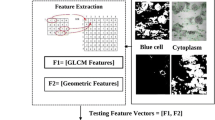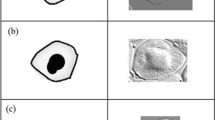Abstract
As cervical cancer is one of the most common cancers worldwide, screening programs have been established. For that task stained slides of cervical cells are visually assessed under a microscope for dysplastic or malignant cells. To support this challenge, image processing methods offer advantages for objective classification. As the cell nuclei carry a high extent visual information, all depicted cell nuclei need to be delineated. Within this work, the expectation maximization (EM) algorithm is evaluated as a yet unused method for this task. The EM was trained on 33 micrographs, where nuclei were manually annotated as reference. The EM was evaluated with varying parameter for the number of classes and with four different color spaces (RGB, Lab, HSV, polar HSV). Segmentation results for all images and parameters were compared to the ground truth, yielding average accuracy and standard deviation for all cells. The best color spaces were RGB and Lab. The best number of classes to be used in the color space was found to be K = 3. It can be concluded that the EM is an appropriate and useful approach for cell nuclei segmentation, but needs some image post-processing for the elimination of false positives.
Access this chapter
Tax calculation will be finalised at checkout
Purchases are for personal use only
Preview
Unable to display preview. Download preview PDF.
Similar content being viewed by others
References
Papanicolaou G. A new procedure for staining vaginal smears. Science. 1942;95:438–9.
Soille P. Morphological Image Analysis: Principles & Applications. Springer; 1999.
Anoraganingrum D, Kröner S, Gottfried B. Cell segmentation with adaptive region growing. Proc Int Conf Image Anal Process. 1999; p. 27–9.
Köhler H, Wittenberg T, Paulus D. Detection and segmentation of cervical cell nuclei. Proc ICMP & BMT, Biomed Tech. 2005;50(1):288–9.
Abmayer W. Einführung in die digitale Bildverarbeitung. Teubner; 1994.
Plissiti M, et al. Automated detection of cell nuclei in PAP stained cervical smear images using fuzzy clustering. In: Proc EMBEC; 2008. p. 637–641.
Loukas C, et al. An image analysis-based approach for automated counting of cancer cell nuclei in tissue sections. Cytometry A. 2003;55A:30–42.
Thomas A, Davies T, Luxmoore A. The Hough transform for locating cell nuclei. In: IEE Colloq Appl Image Proc in Mass Health Screening; 1992. p. 8/1–8/4.
Lindblad J, Bengsston E, Wählby C. Robust cell image segmentation. Pattern Recogn Image Anal. 2004;13(2):157–167.
Dempster A, Laird N, Rubin D. Maximum Likelihood from Incomplete Data via the EM algorithm. J Royal Stat Soc B. 1977;39(1):1–38.
Author information
Authors and Affiliations
Corresponding author
Editor information
Editors and Affiliations
Rights and permissions
Copyright information
© 2011 Springer-Verlag Berlin Heidelberg
About this chapter
Cite this chapter
Ihlow, A., Held, C., Rothaug, C., Dach, C., Wittenberg, T., Steckhan, D. (2011). Evaluation of Expectation Maximization for the Segmentation of Cervical Cell Nuclei. In: Handels, H., Ehrhardt, J., Deserno, T., Meinzer, HP., Tolxdorff, T. (eds) Bildverarbeitung für die Medizin 2011. Informatik aktuell. Springer, Berlin, Heidelberg. https://doi.org/10.1007/978-3-642-19335-4_30
Download citation
DOI: https://doi.org/10.1007/978-3-642-19335-4_30
Published:
Publisher Name: Springer, Berlin, Heidelberg
Print ISBN: 978-3-642-19334-7
Online ISBN: 978-3-642-19335-4
eBook Packages: Computer Science and Engineering (German Language)




